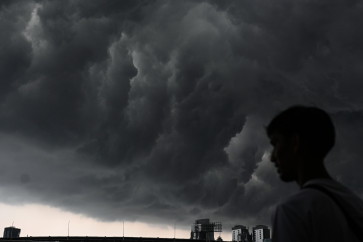Popular Reads
Top Results
Can't find what you're looking for?
View all search resultsPopular Reads
Top Results
Can't find what you're looking for?
View all search resultsYogyakarta woman creates 'transparent mask' to help the deaf communicate in time of coronavirus
The mask design, which replaces the middle section with transparent plastic, is expected to help deaf people to communicate more naturally as it allows them to lip-read.
Change text size
Gift Premium Articles
to Anyone
C
OVID-19 has changed the way people interact with one another, especially with the physical distancing measures in place. It has made basic everyday interactions difficult for most people, including for the deaf community who regularly rely on subtle facial cues to communicate with others.
As more people make a habit out of wearing masks to protect themselves from the contagious virus, communication increasingly becomes a challenge for the deaf community. The problem is masks cover the mouth and the nose area, obscuring visual signs that are otherwise essential for deaf people communicating with others.
Fully cognizant of the issue, Dwi Rahayu Februarti has taken it upon herself to come up with a transparent mask design that aims to make communication a little easier for deaf people during the current health crisis.
The 41-year-old resident of Sinduadi village, Mlati district in Sleman regency in Yogyakarta said the need for masks that allowed others to see lip movements had become increasingly urgent.
“It’s especially worrying since [conventional masks] limit our ability to communicate,” Dwi told The Jakarta Post on Monday. “We often face difficulties speaking with doctors because they also wear conventional masks.”
As of Monday afternoon, Yogyakarta had recorded at least 57 confirmed COVID-19 cases with seven deaths linked to the disease, out of the nationwide official tally of 4,557 infections and 399 fatalities.
Read also: COVID-19 news is not all bad. Read this to stay positive
Dwi, who is head of the local chapter of the Movement for Indonesian Deaf People's Welfare (Gerkatin), said her design for a transparent facemask was inspired by a similar idea shared by National Commission on Violence against Women (Komnas Perempuan) official Bahrul Fuad on Facebook.
Her mask design, which replaces the middle section with transparent plastic, is expected to help deaf people to communicate more naturally as it allows them to lip-read.
The current design has been constantly improved upon feedback from fellow deaf people in her community. The transparent part of the mask, for instance, has been slightly curved to leave ample breathing room for its user, she said.
She went on to say that making a transparent mask was more challenging than producing its conventional counterpart, as one must ensure that the transparent section is precisely aligned to show the mouth of the wearer.
Although Dwi has yet to establish any production targets, she said the demand for the transparent mask was high. She hoped that the design would gain mainstream adoption.
“I plan to record a video on how to produce the transparent mask so that other members of Gerkatin may be able to make their own masks,” Dwi said, adding that her masks had been positively received by the local deaf community.










